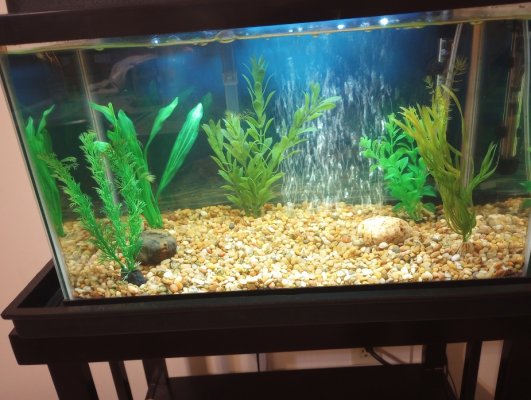This has nothing to do with the Corydoras but you need algae, biofilm and driftwood in the tank for the Otocinclus catfish otherwise they will starve to death. If you leave the aquarium light on for 8-10 hours a day you should get some algae growing on the glass and plants. Driftwood can be bought from pet shops. Biofilm is the clear slime on the inside of the tank on the glass and ornaments. When you clean the tank, wipe the front glass down but leave the back and sides. If they get too gross for you, then wipe one down and wait a few weeks before doing another side, wait a few more weeks before doing the back. But try to leave the back glass to get covered in algae and biofilm.
Having some live plants in the tank wouldn't hurt either. They can remove some nutrients from water and help keep things cleaner.
-----------------
Unless you're keeping hardwater fishes and you have very soft water, there is no need to add the Seachem alkalinity buffer. Corydoras and Otocinclus naturally occur in soft acid water with a very low mineral content. They don't need many minerals in the water.
If you are adding anything to adjust the pH, GH or KH, you should add it to a bucket of water and aerate it for 24 hours before using it in an aquarium with livestock. You should also check the water before adding it to the tank to ensure the pH, GH & KH are where they should be. If they aren't at the desired levels, add more buffer or dilute the bucket of water with some clean water and aerate for another 24 hours, then re-test. Some buffers can continue changing the water many hours later, so you need to aerate the solution for 24 hours to get a more accurate reading.
The Corydoras could do with some hiding places and a piece of driftwood would provide them with cover. A piece could be rested on the 2 rocks you have in the tank and the fish could hide under that during the day and the Otocinclus could graze on it. You can also use clay flower pots, or rocks that don't affect the water chemistry.
-----------------
In the video, the Corydoras is glass surfing and that is fine. However, the Otocinclus on the front glass has very red gills and that could be poisoning from something in the water or gill flukes or gill fungus. It's usually a water quality issue (ammonia, nitrite, nitrate) but can also be from heavy metal poisoning or other hazardous things that dissolve in water. The fact a Corydoras was fine and well in the morning and dead in the evening with no apparent signs of disease, and the water quality was good, might suggest you have something in the water supply that is poisoning the fish.
Perhaps add some carbon to the filter and see how things go over the next couple of months. You will need to replace the carbon every few weeks, depending on how much you use and whether it's in a carbon pad or just a bag of loose carbon granules. The bag of loose carbon granules will last longer than a carbon pad/ cartridge.
You can filter the tap water through carbon before adding it to the tank. This is the preferred thing to do because you aren't adding potentially contaminated water to the tank, then trying to filter it out. You would either run the tap water through a high grade carbon filter, or put a carbon filter in a bucket of tap water and let it run for a couple of days.
-----------------
I would find out exactly what the pH, GH and KH of the water supply is.
I would stop adding the alkalinity buffer.
I would filter the tap water through carbon before using it in the aquarium.
I would add some driftwood and maybe a few live plants.
You could also contact your water supply company via website and get a list of what is in the water. Then post it here. We might be able to find something that shouldn't be in there and that might be contributing to this.

